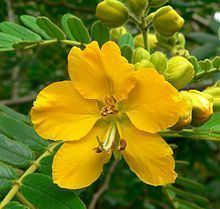Tribe Cassieae Scientific name Senna Higher classification Cassiinae | Subtribe Cassiinae | |
 | ||
Lower classifications | ||
Senna plant
Senna (from Arabic sanā), the sennas, is a large genus of flowering plants in the legume family Fabaceae, and the subfamily Caesalpinioideae. This diverse genus is native throughout the tropics, with a small number of species in temperate regions. The number of Species is estimated to be from about 260 to 350. The type species for the genus is Senna alexandrina. About 50 species of Senna are known in cultivation.
Contents
- Senna plant
- Description
- Systematics
- Ecology
- Uses
- Species
- Species names with uncertain taxonomic status
- References

Description

Senna includes herbs, shrubs, and trees. The leaves are pinnate with opposite paired leaflets. The inflorescences are racemes at the ends of branches or emerging from the leaf axils. The flower has five sepals and five usually yellow petals. There are ten straight stamens. The stamens may be different sizes, and some are staminodes. The fruit is a legume pod containing several seeds.
Systematics

Chamaecrista, Cassia, and Senna form a monophyletic group which some authors have called Cassia sensu lato. In 1982, the group was named Cassiinae and classified as a subtribe of the tribe Cassieae. The tribe Cassieae contains 21 genera and is now known to be polyphyletic, but the classification is still accepted because a revision of Fabaceae has yet to be published.

The genus Senna has had a complex taxonomic history. What is now known as Senna was included by Linnaeus in his concept of Cassia in Species Plantarum in 1753. Philip Miller segregated Senna from Cassia in 1754 in the fourth edition of The Gardeners Dictionary. Until 1982, many authors, following Linnaeus, did not recognize Senna and Chamaecrista, but included them in a broadly circumscribed Cassia sensu lato. Phylogenetic analyses of DNA have shown that Chamaecrista, Cassia, and Senna are all monophyletic, but the relationships between these three genera have not been resolved. They are therefore shown in phylogenetic trees as a tritomy.
Ecology
The caterpillars of many Lepidoptera species feed on Senna plants. The black witch (Ascalapha odorata), two-barred flasher (Astraptes fulgerator), common emigrant (Catopsilia pomona), and mottled emigrant (C. pyranthe) have all been recorded on candle bush (S. alata), for example.
Senna species are pollinated by a variety of bees, especially large female bees in genera such as Xylocopa. Some species also have extrafloral nectaries on the leaves or flower stalks, which attract ants, but do not benefit pollinators. The ants probably deter herbivores.
Uses
Some Senna species are used as ornamental plants in landscaping. The species is adapted to many climate types.
Cassia gum, an extract of the seeds of Chinese senna (S. obtusifolia), is used as a thickening agent. The leaves and flowers of Siamese cassia (S. siamea) are used in some Southeast Asian cuisines, such as Thai and Lao cuisines. They are known as khi-lek in Thai, and are used in curries.
Historically, Egyptian senna (S. alexandrina) was used as a laxative in the form of senna pods, or as herbal tea made from the leaves. Many modern laxatives contain extracts of senna. The active ingredients are several senna glycosides
Species
Senna comprises the following species:
Species names with uncertain taxonomic status
The status of the following species is unresolved:
